- Can you show us some of your photos that you think must to be seen for us to get to know the “common china youth”? What is the story behind them?
With what I’ve observed, there are more than several bold definitions I can think of in a relationship with my pictures and the words, ‘common China youth,’ but I would like to share a couple of pictures.
The first photo (of Mr. Noname) was shot in Xuzhou. One afternoon, I was hanging around in a local skateboard store with him. We had a few talks, but I rather stepped back at a corner to observe him. After a while waiting his friends to come back, he seemed got bored without no entertainment left in the store. He stood up anemically without a word, and stepped in slowly to lay his body down on a floor. I snapped two frames. What I saw was his vulnerability caught my glance in his body posture. After spent two days with him, listening his life story, I came to understand the level of stress, confusion, and despair that he was feeling heavy on his shoulders. A big picture here that I learned was that the current social system and highly competitive employment as a trigger facilitate to produce many obstacles and pressure as consequence for the young. Like many other typical youth, he had no luck of finding job after a design school. At the time of my interview, he possessed neither a clear future vision nor an aspiration. He seemed to be a luck of motivation. I’ve met a great number of youths who dealt with the same struggle. More number of the educated young increases, more competitive becomes the employment opportunity. It is indispensable that a number of youth like Mr. Noname will hit higher degree.
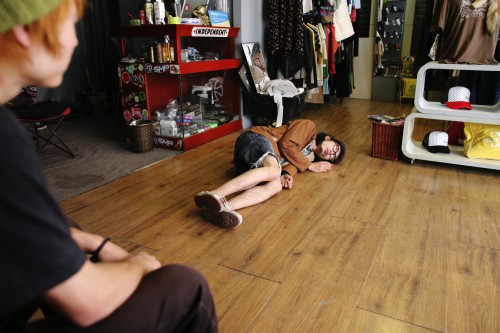
Another photo (dream and firework) could be subtle, but for me it’s a visual representation of Chinese youth, who is on his way to complete all three youth wishes. The photograph was shot in Jilin on a night when a restaurant cerebrated its opening night. When I heard the fireworks, I was in my hotel room, downloading pictures of the day into my computer. I left a card reader to do its job, and run outside with my camera. A line of rides stopped on a street for the free entertainment. I snapped randomly all curious observers gathered on the street. A driver leaned out from a window looking up enviously caught my eyes. During my trip, three wishes, which the young I encountered repeatedly answered as if written in a manual, were “a nice car,” “a nice house,” and “family.” In the picture, I saw a man with completed one of the three wishes, seemed to be dreaming for other two as the art of fireworks illuminated the night.
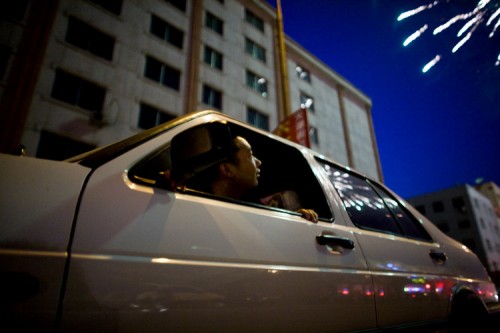
- I know there was an exhibition of your photos there. Can you tell us more about it?
It was a part of the collective art exhibition organized by Beijing Center for Arts in Tianmen Square 23. My portraits and candid photos were presented in collaboration with a documentary video done by Jay Caplan from China Youthology, and a brief writing presented by members of China Youthology. Our exhibition space were organized in two parts. One presented a series of portraits, in which each portrait was lined with three questionaries and its handwritten answers by a portrait subject. The other part showed Jay’s documentary video, in which the a TV set was juxtaposed within an environmental photo (1.8m on the longest side). At the opening ceremony, I’ve received great reaction and encouraging feedback. I found many other inspiring participant works. It would be extra points if I could answer a question in Chinese….
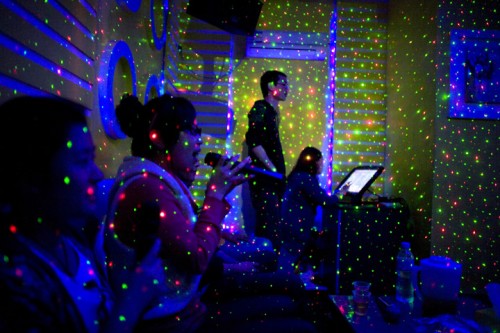
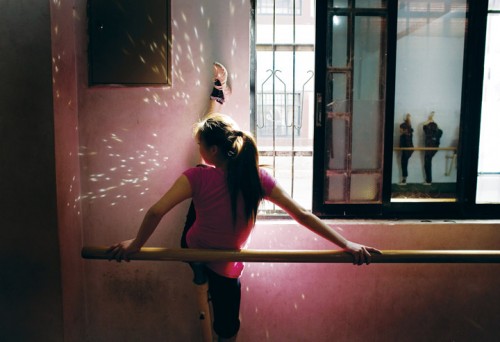
- Do you have any difficulty on doing your project? How you make a living?
The two biggest obstacles I currently face are how to financially sustain my project, and how to overcome communication barrier. For the former obstacle, my not-photo-related part time jobs help me to support my passion. It’s far from an ideal life, but I don’t have an alternative choice for now. The latter challenge needs more immediate solution. A quote by Antonie d’Agata says that “It’s not how a photographer looks at the world that is important. It’s their intimate relationship with it.” I believe that a photograph is a very mirror of ourself. It reflects everything about the photographer and her or his relationship with a subject. I take documentary photography as an advocative approach rather than journalistic observation. The well-understanding of a subject is a must, and the language is fundamental to carry out that purpose. Currently, either a translator or English would do my communication with locals youth in China. (I go to Chinese language school every morning though…有进步,但是慢慢的) No matter where I go or how I live, an obstacle always stands up against us. At least, I choose to take these hardships, not given by someone else.
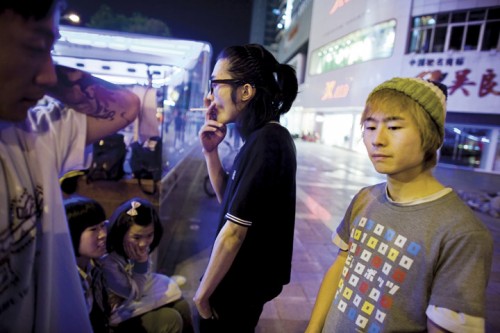
- Please recommend us some your favorite photography books
I would say when I first saw “The Beautiful Smile (The Hasselblad Award 2007)” by Nan Goldin, it was shockingly fresh, and at some extent I felt slightly frightened, yet it left me with a deep reverence and admiration for its intense moments and her intimate relationship with a subject. I feel ashamed that I never actually own that book. But, I remember that I run straight to a secondhand book store in New York City just to see her book every time I finished my part-time job nearby that bookstore.
- Is there anything you want to say except my question.
I will be attending to “Angkor Photo Festival & Workshop” in Cambodia in this month (November 2010). After the portfolio selection, I’ve received an honorable acceptance for 30 young emerging Asian photographers for the Free Workshop. Along with the city-size photography festival in Siem Reap, Cambodia, this workshop aims to guide “photographers across Asia who work in photojournalism and documentary-based photography,” in developing “the skills to better document their own society, understanding universal ethical and professional standards, and eventually create a vibrant photographic network across Asia.” The workshop participants are expected to find a story, and produce a photo reportage within a week of their stay. I’m very stoked about this opportunity as well as talented students and mentors whom I’m going to meet in two weeks!! One downside of this workshop is that I don’t see a workshop participant from China for this year. This sixth year’s “free of charge and free of accommodation” workshop will be a great opportunity to challenge the world standard of photojournalism and documentary photography. I would love to discuss my experience with anyone who is interested in for applying to the one of 2011.
Angkor Photo Festival & workshop:
http://www.photographyforchange.net/festivalhome.html
The workshop Blog:
http://apws.wordpress.com/
Go Takayama:gotakayamaphoto@gmail.com
Most pleased to be able to access this interview in both English and Chinese! His style has a very Tokyo-edge to it, very nice to see it on display in China.